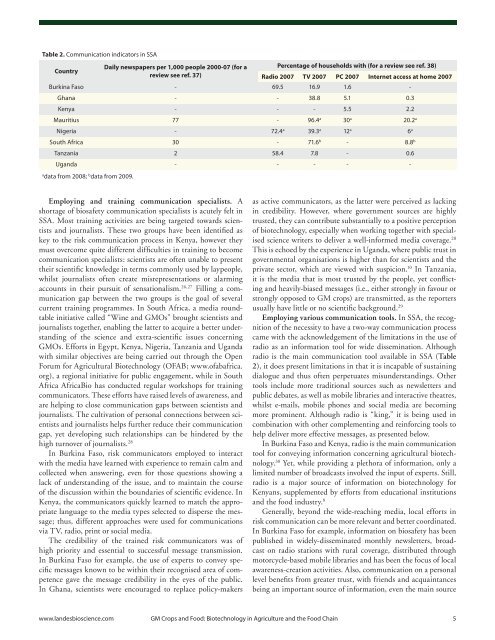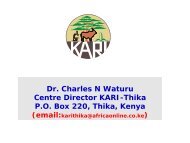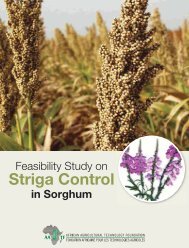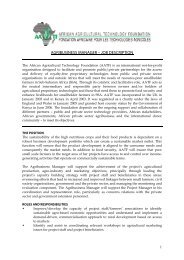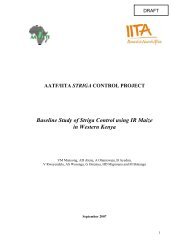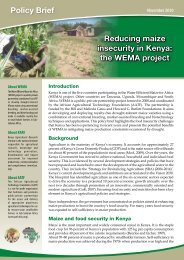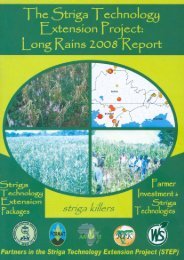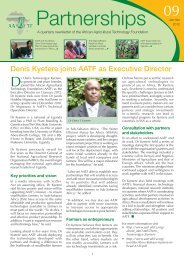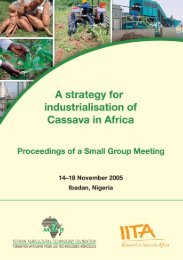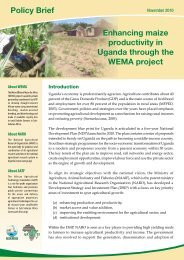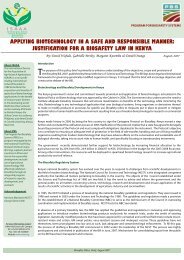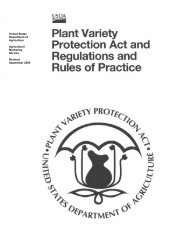Experiences in sub-Saharan Africa with GM crop risk communication
Experiences in sub-Saharan Africa with GM crop risk communication
Experiences in sub-Saharan Africa with GM crop risk communication
Create successful ePaper yourself
Turn your PDF publications into a flip-book with our unique Google optimized e-Paper software.
Table 2. Communication <strong>in</strong>dicators <strong>in</strong> SSA<br />
Country<br />
Daily newspapers per 1,000 people 2000-07 (for a<br />
Percentage of households <strong>with</strong> (for a review see ref. 38)<br />
review see ref. 37)<br />
Radio 2007 TV 2007 PC 2007 Internet access at home 2007<br />
Burk<strong>in</strong>a Faso - 69.5 16.9 1.6 -<br />
Ghana - - 38.8 5.1 0.3<br />
Kenya - - - 5.5 2.2<br />
Mauritius 77 - 96.4 a 30 a 20.2 a<br />
Nigeria - 72.4 a 39.3 a 12 a 6 a<br />
South <strong>Africa</strong> 30 - 71.6 b - 8.8 b<br />
Tanzania 2 58.4 7.8 - 0.6<br />
Uganda - - - - -<br />
a<br />
data from 2008; b data from 2009.<br />
Employ<strong>in</strong>g and tra<strong>in</strong><strong>in</strong>g <strong>communication</strong> specialists. A<br />
shortage of biosafety <strong>communication</strong> specialists is acutely felt <strong>in</strong><br />
SSA. Most tra<strong>in</strong><strong>in</strong>g activities are be<strong>in</strong>g targeted towards scientists<br />
and journalists. These two groups have been identified as<br />
key to the <strong>risk</strong> <strong>communication</strong> process <strong>in</strong> Kenya, however they<br />
must overcome quite different difficulties <strong>in</strong> tra<strong>in</strong><strong>in</strong>g to become<br />
<strong>communication</strong> specialists: scientists are often unable to present<br />
their scientific knowledge <strong>in</strong> terms commonly used by laypeople,<br />
whilst journalists often create misrepresentations or alarm<strong>in</strong>g<br />
accounts <strong>in</strong> their pursuit of sensationalism. 26,27 Fill<strong>in</strong>g a <strong>communication</strong><br />
gap between the two groups is the goal of several<br />
current tra<strong>in</strong><strong>in</strong>g programmes. In South <strong>Africa</strong>, a media roundtable<br />
<strong>in</strong>itiative called “W<strong>in</strong>e and <strong>GM</strong>Os” brought scientists and<br />
journalists together, enabl<strong>in</strong>g the latter to acquire a better understand<strong>in</strong>g<br />
of the science and extra-scientific issues concern<strong>in</strong>g<br />
<strong>GM</strong>Os. Efforts <strong>in</strong> Egypt, Kenya, Nigeria, Tanzania and Uganda<br />
<strong>with</strong> similar objectives are be<strong>in</strong>g carried out through the Open<br />
Forum for Agricultural Biotechnology (OFAB; www.ofabafrica.<br />
org), a regional <strong>in</strong>itiative for public engagement, while <strong>in</strong> South<br />
<strong>Africa</strong> <strong>Africa</strong>Bio has conducted regular workshops for tra<strong>in</strong><strong>in</strong>g<br />
communicators. These efforts have raised levels of awareness, and<br />
are help<strong>in</strong>g to close <strong>communication</strong> gaps between scientists and<br />
journalists. The cultivation of personal connections between scientists<br />
and journalists helps further reduce their <strong>communication</strong><br />
gap, yet develop<strong>in</strong>g such relationships can be h<strong>in</strong>dered by the<br />
high turnover of journalists. 28<br />
In Burk<strong>in</strong>a Faso, <strong>risk</strong> communicators employed to <strong>in</strong>teract<br />
<strong>with</strong> the media have learned <strong>with</strong> experience to rema<strong>in</strong> calm and<br />
collected when answer<strong>in</strong>g, even for those questions show<strong>in</strong>g a<br />
lack of understand<strong>in</strong>g of the issue, and to ma<strong>in</strong>ta<strong>in</strong> the course<br />
of the discussion <strong>with</strong><strong>in</strong> the boundaries of scientific evidence. In<br />
Kenya, the communicators quickly learned to match the appropriate<br />
language to the media types selected to disperse the message;<br />
thus, different approaches were used for <strong>communication</strong>s<br />
via TV, radio, pr<strong>in</strong>t or social media.<br />
The credibility of the tra<strong>in</strong>ed <strong>risk</strong> communicators was of<br />
high priority and essential to successful message transmission.<br />
In Burk<strong>in</strong>a Faso for example, the use of experts to convey specific<br />
messages known to be <strong>with</strong><strong>in</strong> their recognised area of competence<br />
gave the message credibility <strong>in</strong> the eyes of the public.<br />
In Ghana, scientists were encouraged to replace policy-makers<br />
as active communicators, as the latter were perceived as lack<strong>in</strong>g<br />
<strong>in</strong> credibility. However, where government sources are highly<br />
trusted, they can contribute <strong>sub</strong>stantially to a positive perception<br />
of biotechnology, especially when work<strong>in</strong>g together <strong>with</strong> specialised<br />
science writers to deliver a well-<strong>in</strong>formed media coverage. 28<br />
This is echoed by the experience <strong>in</strong> Uganda, where public trust <strong>in</strong><br />
governmental organisations is higher than for scientists and the<br />
private sector, which are viewed <strong>with</strong> suspicion. 10 In Tanzania,<br />
it is the media that is most trusted by the people, yet conflict<strong>in</strong>g<br />
and heavily-biased messages (i.e., either strongly <strong>in</strong> favour or<br />
strongly opposed to <strong>GM</strong> <strong>crop</strong>s) are transmitted, as the reporters<br />
usually have little or no scientific background. 29<br />
Employ<strong>in</strong>g various <strong>communication</strong> tools. In SSA, the recognition<br />
of the necessity to have a two-way <strong>communication</strong> process<br />
came <strong>with</strong> the acknowledgement of the limitations <strong>in</strong> the use of<br />
radio as an <strong>in</strong>formation tool for wide dissem<strong>in</strong>ation. Although<br />
radio is the ma<strong>in</strong> <strong>communication</strong> tool available <strong>in</strong> SSA (Table<br />
2), it does present limitations <strong>in</strong> that it is <strong>in</strong>capable of susta<strong>in</strong><strong>in</strong>g<br />
dialogue and thus often perpetuates misunderstand<strong>in</strong>gs. Other<br />
tools <strong>in</strong>clude more traditional sources such as newsletters and<br />
public debates, as well as mobile libraries and <strong>in</strong>teractive theatres,<br />
whilst e-mails, mobile phones and social media are becom<strong>in</strong>g<br />
more prom<strong>in</strong>ent. Although radio is “k<strong>in</strong>g,” it is be<strong>in</strong>g used <strong>in</strong><br />
comb<strong>in</strong>ation <strong>with</strong> other complement<strong>in</strong>g and re<strong>in</strong>forc<strong>in</strong>g tools to<br />
help deliver more effective messages, as presented below.<br />
In Burk<strong>in</strong>a Faso and Kenya, radio is the ma<strong>in</strong> <strong>communication</strong><br />
tool for convey<strong>in</strong>g <strong>in</strong>formation concern<strong>in</strong>g agricultural biotechnology.<br />
30 Yet, while provid<strong>in</strong>g a plethora of <strong>in</strong>formation, only a<br />
limited number of broadcasts <strong>in</strong>volved the <strong>in</strong>put of experts. Still,<br />
radio is a major source of <strong>in</strong>formation on biotechnology for<br />
Kenyans, supplemented by efforts from educational <strong>in</strong>stitutions<br />
and the food <strong>in</strong>dustry. 8<br />
Generally, beyond the wide-reach<strong>in</strong>g media, local efforts <strong>in</strong><br />
<strong>risk</strong> <strong>communication</strong> can be more relevant and better coord<strong>in</strong>ated.<br />
In Burk<strong>in</strong>a Faso for example, <strong>in</strong>formation on biosafety has been<br />
published <strong>in</strong> widely-dissem<strong>in</strong>ated monthly newsletters, broadcast<br />
on radio stations <strong>with</strong> rural coverage, distributed through<br />
motorcycle-based mobile libraries and has been the focus of local<br />
awareness-creation activities. Also, <strong>communication</strong> on a personal<br />
level benefits from greater trust, <strong>with</strong> friends and acqua<strong>in</strong>tances<br />
be<strong>in</strong>g an important source of <strong>in</strong>formation, even the ma<strong>in</strong> source<br />
www.landesbioscience.com <strong>GM</strong> Crops and Food: Biotechnology <strong>in</strong> Agriculture and the Food Cha<strong>in</strong> 5


